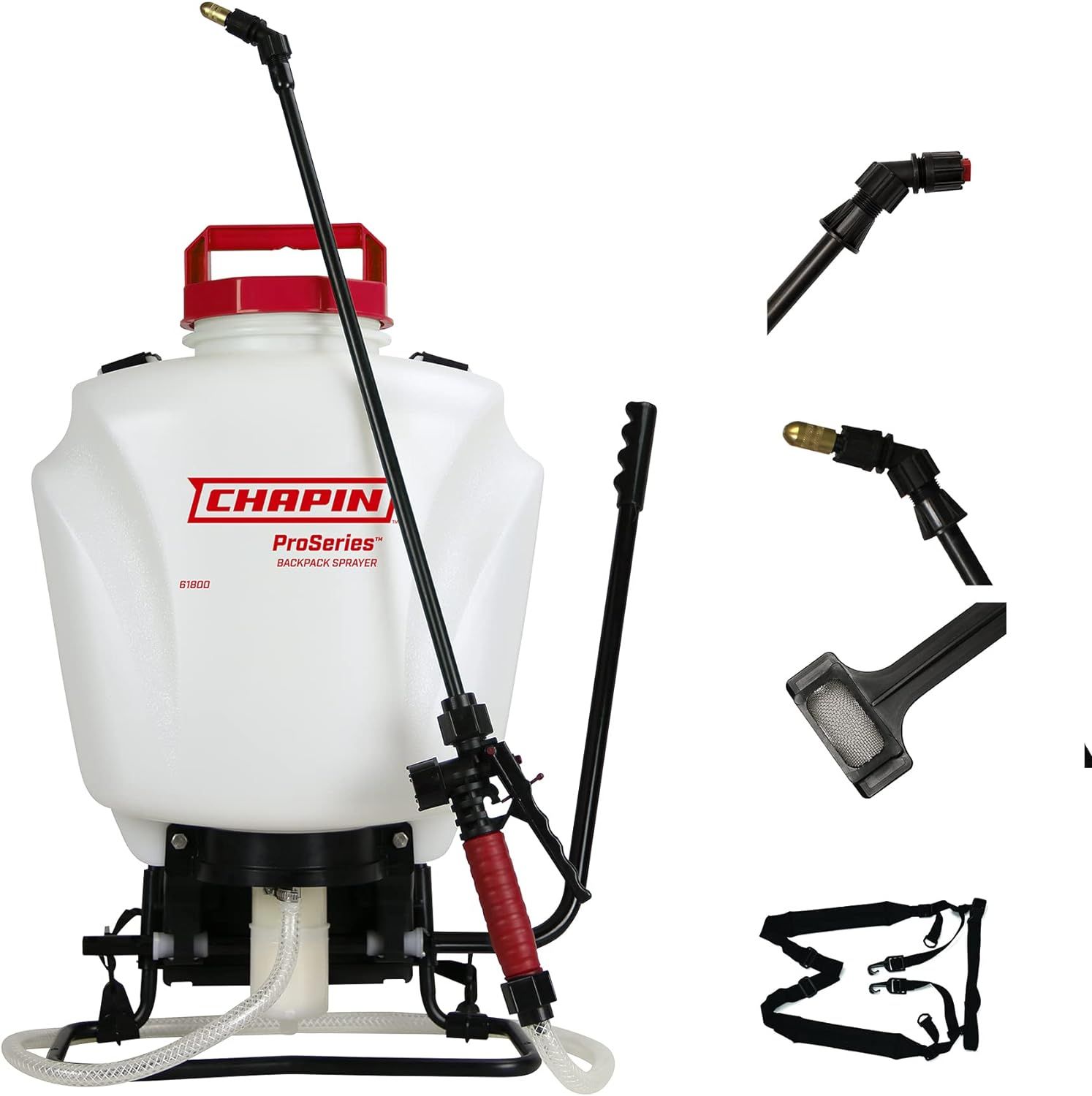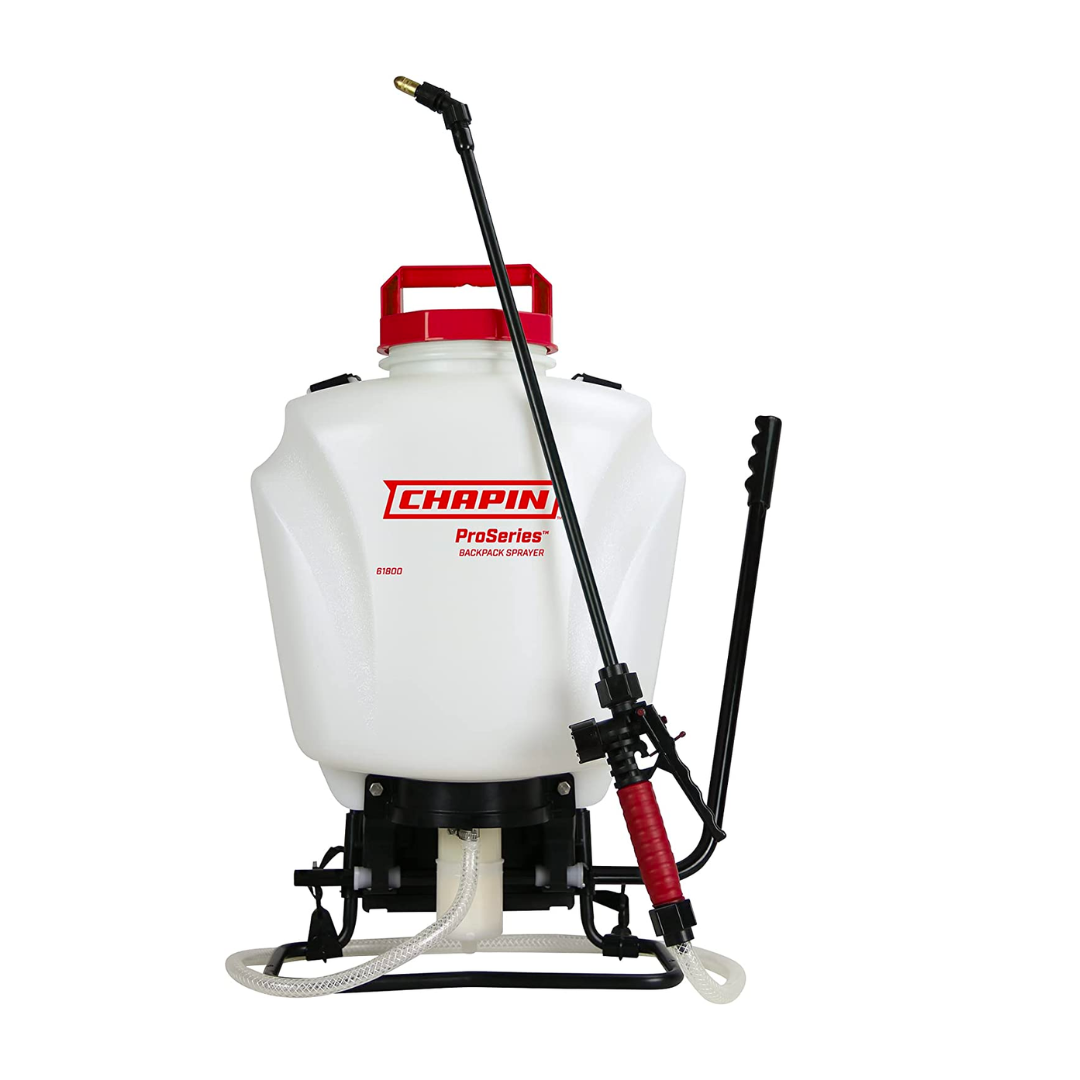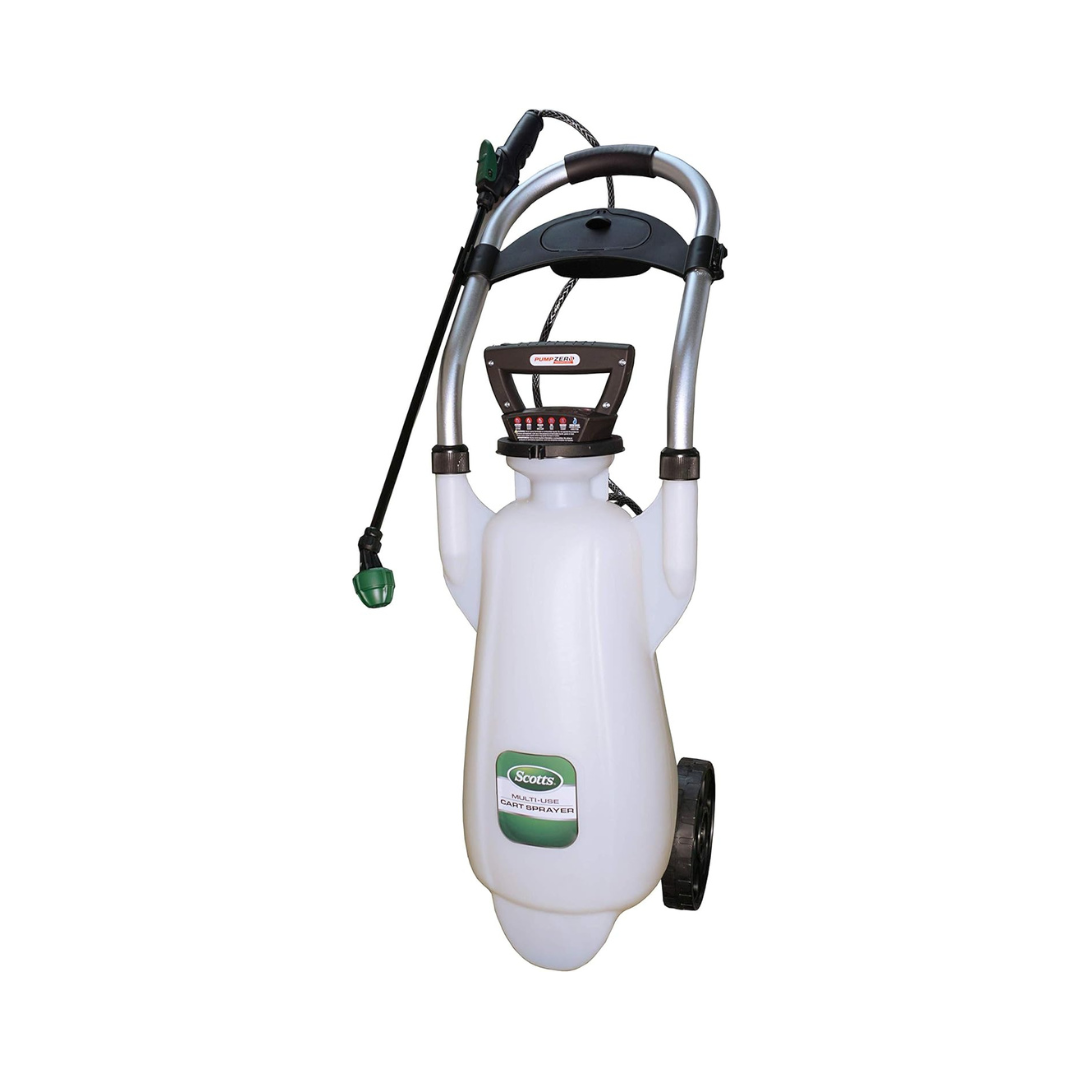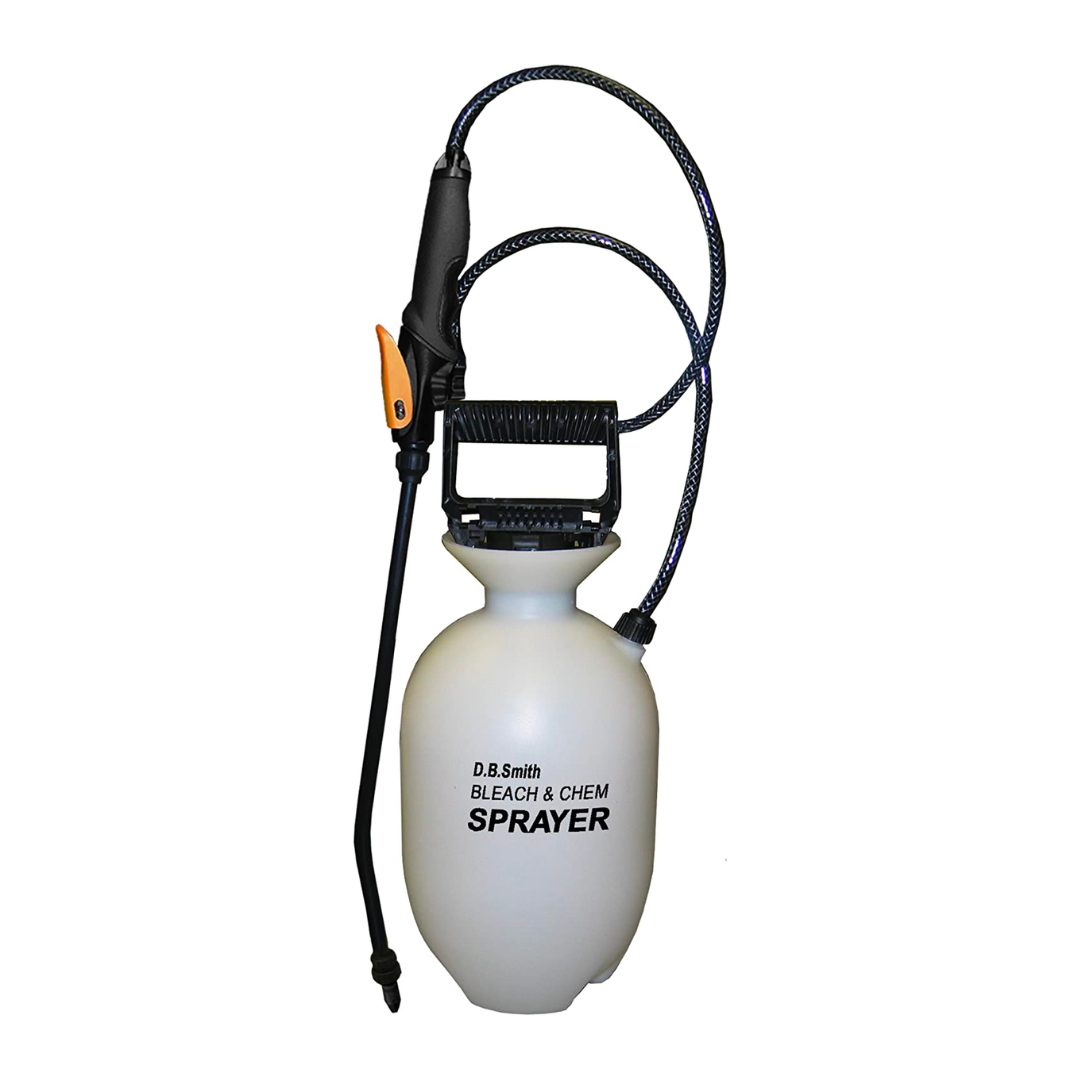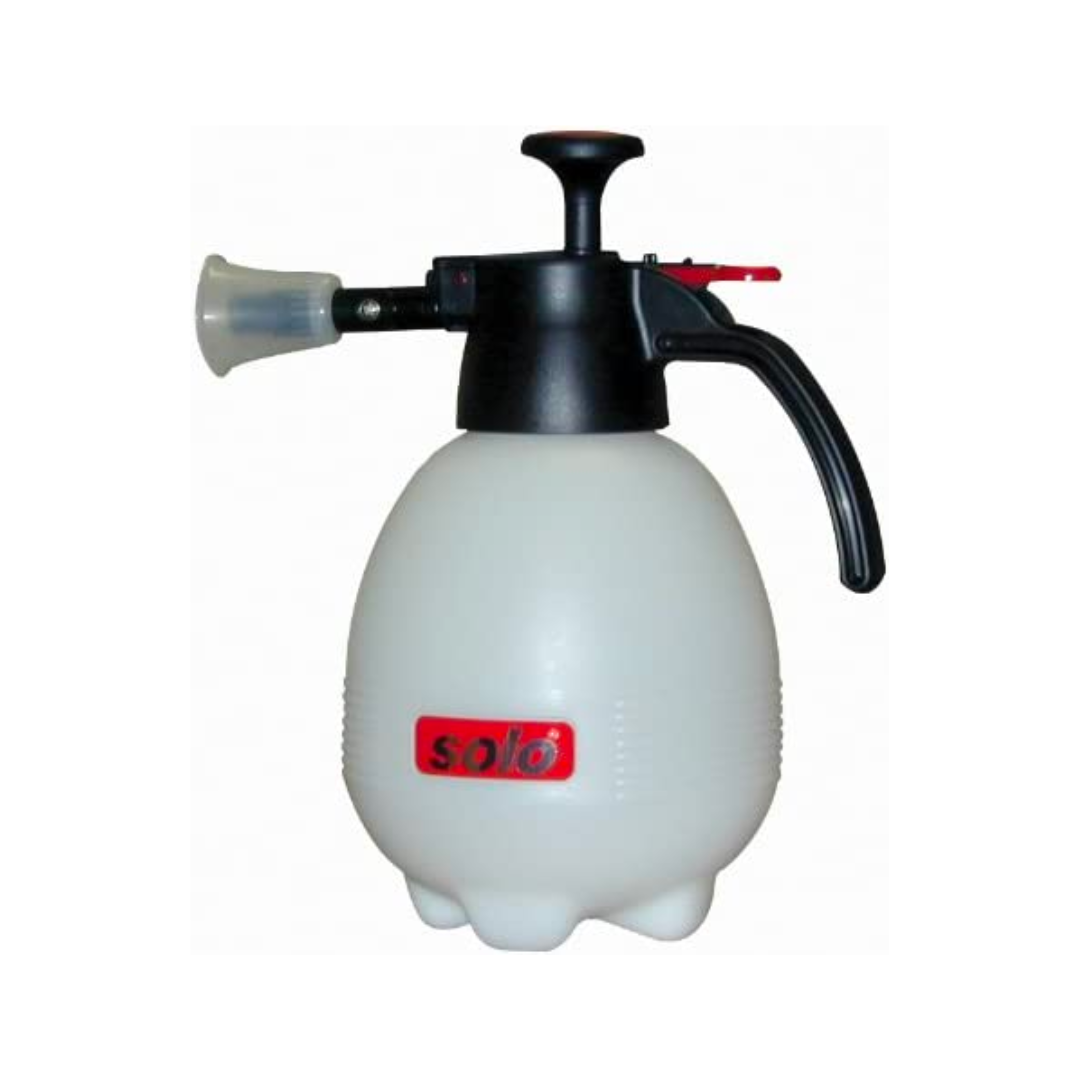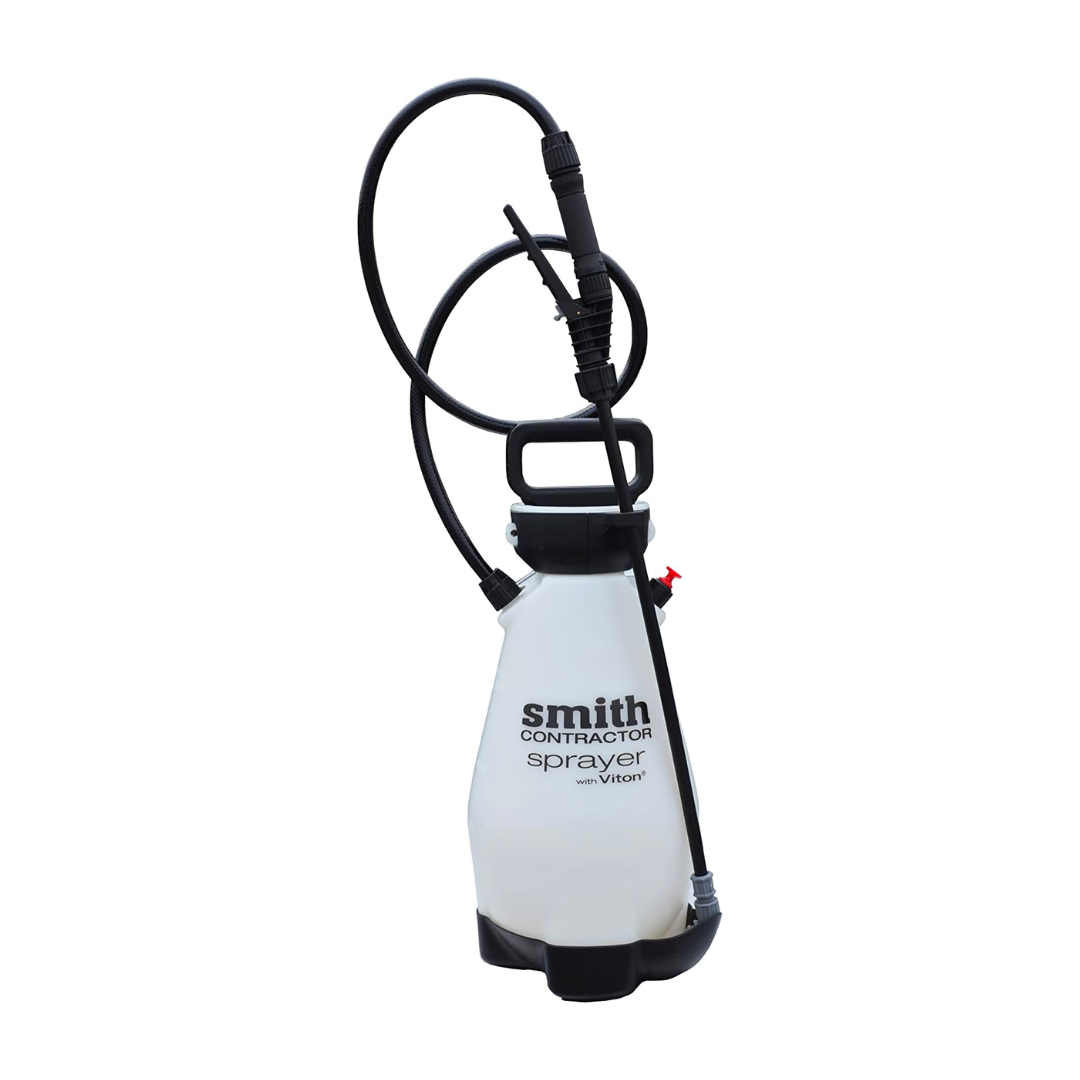We may be compensated if you purchase through links on our website. Our team is committed to delivering honest, objective, and independent reviews on home products and services.
- The best chemical sprayer in 2024 is the Chapin Backpack Sprayer as it offers consistent spraying and allows you to comfortably carry it’s 4-gallon tank with you on the go.
- Chemical sprayers cost between $15 and $150, but our experts believe you don’t necessarily need to break the bank to get the job done.
- A chemical sprayer is a great tool for gardeners and DIYers that want to keep their lawn manicured and free of weeds.
Even the most well-manicured lawns and gardens can be susceptible to weeds and pests. A chemical sprayer may be able to serve as a weed killer and help you get the beautiful yard you’ve worked hard on. Chemical sprayers can be used for landscaping, painting, staining, and washing.
Our team of experts share more details on the best chemical sprayers below.
Sprayers For Chemicals: Reviews
Sprayers for chemicals vary, in the way they spray chemicals, the way they’re transported, and more. Before our experts delve into in-depth reviews, it’s worth comparing key features at a glance:
Compare Chemical Sprayers
| Product | Tank Capacity | Hose Length | # of Spray Modes | Weight | |
|---|---|---|---|---|---|
| Chapin International 4-Gallon Backpack Sprayer | 4 gallons | 48 inches | 3 | 9.2 pounds | |
| Scotts Lithium-ion Zero Wheeled Sprayer | 3 gallons | 29 inches | 3 | 9 pounds | |
| D.B. Smith 1-Gallon Bleach and Chemical Sprayer | 1 gallon | 36 inches | 2 | 1 pound | |
| SOLO One-Hand Pressure Sprayer | 2 liters | n/a | Multiple (not specified) | 1 pound | |
| D.B. Smith 2-Gallon Chemical Sprayer | 2 gallon | Not listed | 5 | 5 pounds | |
| VIVOSUN Pump Pressure Sprayer | 1.35 gallons | 50 inches | 2 | 3 pounds | |
| Product | Tank Capacity | Hose Length | # of Spray Modes | Weight |
Chapin Backpack Sprayer: Best Chemical Sprayer
- Tank capacity: 4 gallons
- Hose length: 48 inches
- Spray modes: Three
- Weight: 9.2 pounds (lbs.)
Backpack Sprayer (Chapin): Pros and Cons
✔ The Chapin Backpack Sprayer includes padded shoulder straps for added lumbar support
✔ The 4-gallon tank allows you to cover more ground
✔ Is made in the USA using global materials
✘ Heavy to strap on when it’s full
✘ Requires some coordination, as you have to pump and spray simultaneously
Chapin Pro Series Backpack Sprayer: What Customers Are Saying
Customers were satisfied with the Chapin Pro Series Backpack sprayer, citing its easy assembly, consistent spraying ability, and overall parts quality. On the other hand, several customers complained about the comfort of the backpack chemical sprayer’s straps, stating that they were too thin and didn’t fully support the weight of the full tank.
Scotts Lithium-Ion Sprayer: Best Chemical Spray Wand
- Tank capacity: 3 gallons
- Hose length: 29 inches
- Spray modes: Three
- Weight: 9 lbs.
Scotts Lithium-Ion Sprayer: Pros and Cons
✔ Has a comfortable grip
✔ Features a three-in-one nozzle with fan, stream, and cone spray options
✔ Is powered by a rechargeable lithium-ion battery
✘ Has a high price point
✘ Some customers said it clogged easily
Scotts Lithium-Ion Sprayer: What Customers Are Saying
The Scotts Lithium-Ion Sprayer received primarily positive reviews, with most customers highlighting its ease-of-use and mobility. Others like that it came with a long wand and adjustable nozzle. Conversely, some customers experienced clogging with this device, and others said it didn’t always charge properly.
D.B. Smith 1-Gallon Sprayer: Best Chemical-Resistant Pump Sprayer
- Tank capacity: 1 gallon
- Hose length: 36 inches
- Spray modes: Two
- Weight: One pound
D.B. Smith Sprayer (1-Gallon): Pros and Cons
✔ Its spray tip is easy to adjust
✔ Provides ample pressure with little pumping required
✔ The shut-off features a comfortable grip that locks on for continuous spraying
✘ Some customers found the product instructions to be confusing and unclear
✘ The sprayer doesn’t have a pressure release valve
D.B. Smith 1-Gallon Sprayer: What Customers Are Saying
Positively, we note that several users say that the D.B. Smith 1-Gallon sprayer functions perfectly as a large-scale sanitizer and as a garden fertilizer. They added that the sprayer was reasonably priced, stood up nicely to wear and tear, and didn’t corrode. Negatively, some customers mention that the sprayer clogged fairly easily, requiring them to lubricate its plastic threads and twist tightly to maintain a proper seal.
SOLO Hand Sprayer: Best Handheld Chemical Sprayer
- Tank capacity: 2 liters
- Hose length: N/A
- Spray modes: Multiple
- Weight: One pound
SOLO 418 2-Liter One-Hand Pressure Sprayer: Pros and Cons
✔ Features a drip guard for target treatment
✔ Comes with a locking trigger and pressure relief valve
✔ Is lightweight at only 1 pound
✘ Has a small capacity of only 1 liter, requiring frequent refills for large areas
✘ Some customers reported weak pressure and potential leakage
SOLO 418 One-Hand Pressure Sprayer: What Customers Are Saying
The pros that customers highlighted in their positive reviews included the thickness and durability of the SOLO 418 One-Hand Pressure Sprayer, the nozzle’s easy adjustability, the sprayer’s comfortable ergonomics, and the sprayer’s ability to maintain pressure. Cons that our team found mentioned in certain reviews included the sprayer’s short wand and lack of stability when the container was placed on a flat surface.
D.B. Smith 2-Gallon Chemical Sprayer: Best 2-Gal. Pump Sprayer
- Tank capacity: 2 gallon
- Hose length: N/A
- Spray modes: 5
- Weight: 5 lbs.
D.B. Smith 2-Gal. Contractor Sprayer: Pros and Cons
✔ Offers commercial-grade durability and spraying performance
✔ Features a long, 21-inch wand
✔ The in-line filter prevents clogs, making the sprayer easy to clean
✘ Expensive
✘ Some customers had to pump the sprayer more often than they wished
D.B. Smith Sprayer (2 Gallon): What Customers Are Saying
Customers we found who were happy with the performance of the D.B. Smith 2-Gal. contractor sprayer said that it was a high-quality model, outperforming other sprayers on the market. In their positive reviews, they included that the pump action was smooth, the tank was thick and solid, and the included nozzle attachments made it versatile. There were some complaints about the sprayer leaking out of its nozzle instead of immediately shutting off, and some customers said that the wand wasn’t stiff enough during use.
VIVOSUN Compression Sprayer: Best Value Chemical Sprayer
- Tank capacity: 1.35 gallons
- Hose length: 50 inches
- Spray modes: 2
- Weight: 3 lbs.
VIVOSUN 1.35-Gallon Pump Pressure Sprayer: Pros and Cons
✔ Features a large bowl that’s easy to fill
✔ Is available in multiple sizes
✔ Can be used indoors or outdoors
✘ Has fewer spray settings than other similar products
✘ Some customers said it did a poor job of holding pressure
VIVOSUN Compression Sprayer: What Customers Are Saying
Our team noted that the VIVOSUN Compression Sprayer received positive reviews for its durability, lightweight design, and excellent flow rate. However, we found that several customers noted that it had difficulty holding pressure, while others said that it had a poor spray pattern.
Chemical Spray: Buying Guide
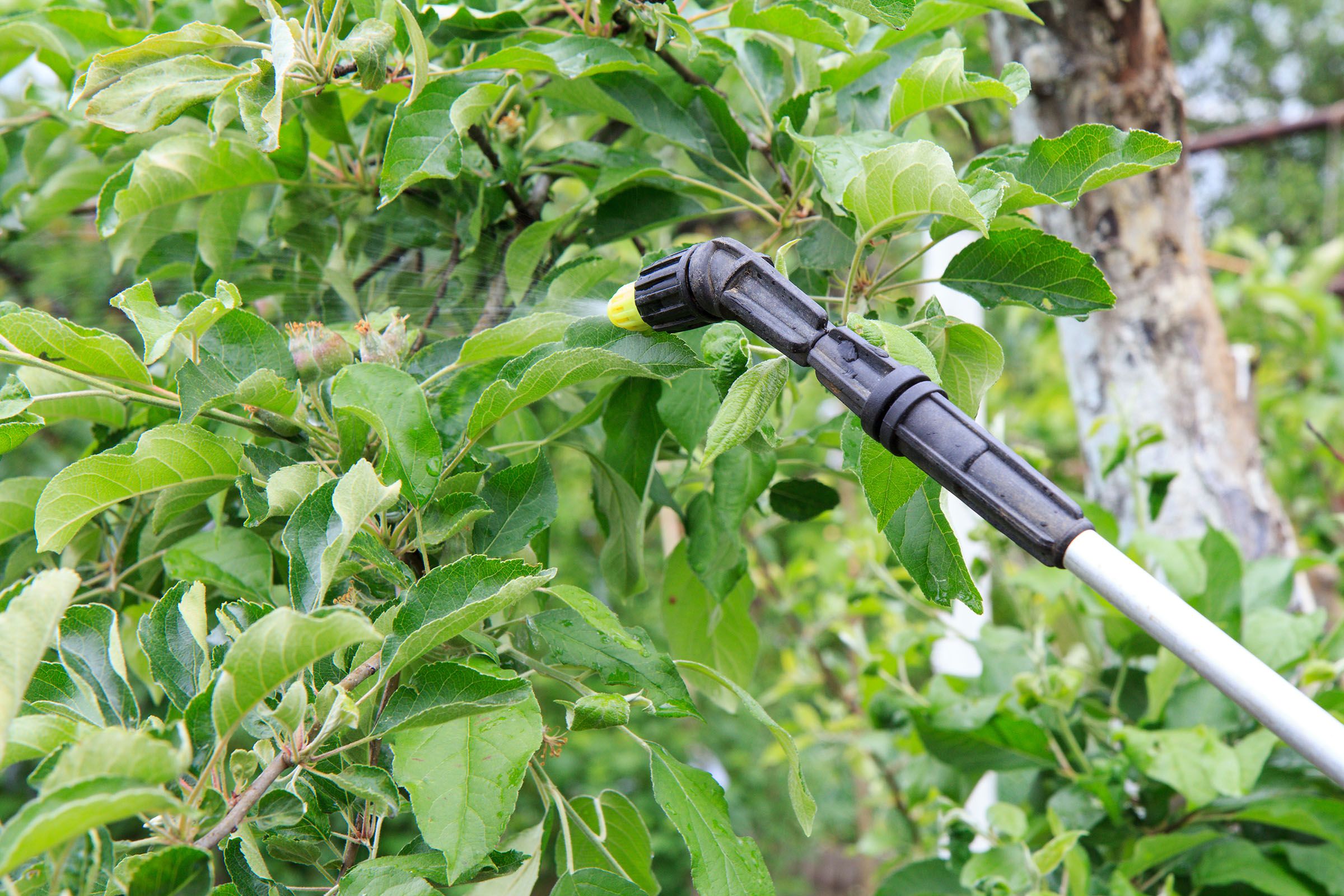
Chemical or garden sprayers are a cost-effective alternative to hiring a landscaping company to spray your yard for invasive plants and pests. By taking on this task yourself, you have control over the herbicides and pesticides that you use in your yard and around your house.
In fact, you don’t even have to use harsh chemicals in a chemical sprayer—just fill it with water and give your houseplants a good soak. You can also fill these sprayers with soap and water to clean siding or fill them with paint to stain a deck.
You don’t have to have a green thumb to use a sprayer. Most are versatile and easy to use. To learn more about selecting a chemical sprayer, continue reading our guide below.
Types of Chemical Sprayers
There are a number of different types of chemical sprayers, each with their own benefits and drawbacks. Below are the different types of chemical sprayers:
Battery-Powered Chemical Sprayer
Similar to gas-powered sprayers, battery-operated sprayers do the pumping for you, so you can focus your efforts on spraying.
- Pros: They’re still easier to use than a manual pump sprayer, and they’re available in a variety of types: handheld, backpack, and wheeled sprayers.
- Cons: You’ll be limited to battery life, and you’ll pay a higher price than a pump sprayer.
Gas-Powered Chemical Sprayer
These motorized sprayers have an engine that pumps the solution from the tank through the sprayer, eliminating the need to manually pump the machine.
- Pros: These are arguably the easiest to use since you just point and spray—no manual pumping is required. They usually include more attachments and accessories than other sprayers.
- Cons: These heavy-duty sprayers are the most expensive. Not only do they emit fumes, but they’re also big and bulky. Fortunately, most gas-powered sprayers come on wheels.
Chemical Pump Sprayer
Pump-action sprayers require you to regularly pump the solution during use. Pressure builds with each pump, so you can control how powerful your sprayer is.
- Pros: You’ll have the most control with a manual pump garden sprayer. Without the weight of gas or a battery, these are the most portable sprayers. They’re also the most affordable.
- Cons: Manual labor requires some coordination and can lead to fatigue.
Chemical Sprayer: Maintenance
Leaving chemicals in your sprayer for too long can lead to residue buildup that damages your sprayer and your plants. Here’s how to keep your chemical sprayer in top condition.
- Empty the mixture immediately after each use. If you overfill your tank, you may have to spray your yard twice.
- Rinse the residue with detergent or ammonia. You may let this cleaning solution sit in your sprayer overnight.
- Wash nozzles and attachments.
- Spray half a tank with hot, clean water. This will flush out stubborn residue.
Safety Measures In Spraying Chemicals
You should take safety measures when spraying harsh chemicals. Here are a few general guidelines to keep in mind:
- Do your research before mixing chemicals.
- Protect your skin by wearing work gloves, long sleeves, and pants.
- Personal safety gear and protective glasses are highly recommended.
- Depressurize your sprayer before opening it.
- Do not use a chemical sprayer around children or pets.
- Remove any toys and electronics from the yard before spraying.
- Adequately cover your hot tub, pond, pool, and any outdoor furniture prior to application.
- Avoid spraying on a windy day. Airborne chemicals may negatively affect untargeted areas by entering the home, water sources, and neighboring areas.
- Wash your hands and clothing immediately after using a chemical sprayer.
- If you’ve sprayed your edible garden, wash your harvested fruits and vegetables thoroughly before consuming them.
Don’t dump chemicals on your yard, flowers, trash, or even down your drain. Refer to the manufacturer’s disposal recommendations or contact your local health or environmental department.
How To Use A Chemical Sprayer
You don’t have to use chemicals in a chemical sprayer. You can fill it with different types of cleaning solutions, from diluted vinegar to commercial degreasers.
- Garden sprayers aren’t as powerful as pressure washers, but they are handy for rinsing off your car, siding, or driveway.
- Cut through grease on just about anything with an engine.
- Stain a fence or apply deck paint by attaching a paint filter to your spray wand.
- Some homeowners have reportedly used garden sprayers inside their homes to shampoo their carpets.
Best Sprayer For Chemicals: Our Conclusion
The best sprayer for chemicals ultimately depends on your needs. If you’re going to be spraying chemicals for an extended period of time, a backpack chemical sprayer may be the best option. However, we highlight a range of different options for a variety of needs below:
- Best Chemical Sprayer: Chapin Backpack Sprayer
- Best Chemical Spray Wand: Scotts Lithium-Ion Sprayer
- Best Chemical-Resistant Pump Sprayer: D.B. Smith 1-Gallon Sprayer
- Best Handheld Chemical Sprayer: SOLO Hand Sprayer
- Best 2-Gal. Pump Sprayer: D.B. Smith 2-Gallon Chemical Sprayer
- Best Value Chemical Sprayer: VIVOSUN Compression Sprayer
Chemical Sprayers: FAQ
Below are some frequently asked questions about chemical sprayers:
Are chemical sprayers safe?
If you fill your chemical sprayer with chemicals (i.e. herbicides, insecticides, and pesticides), you should take extreme safety precautions.
Wear protective clothing and eyewear, spray away from children and pets, and wash your sprayer, hands, and clothes thoroughly after each use.
Using natural cleaning solutions in your sprayer will decrease the health and environmental risks of using a garden sprayer at home.
How long should you stay off the grass after spraying pesticide?
Refer to the label for specifics, but most pesticide manufacturers recommend staying off treated grass for at least six hours. We recommend staying off your grass for 24–48 hours.
What precautions should be taken while using pesticides?
Pesticides may contaminate drinking water, food, and soil, and they’re most dangerous when inhaled, ingested, or exposed to the skin of both humans and animals.
Always wear protective clothing when using your sprayer and clean the equipment after each use. You will find proper transportation, storage, and disposal instructions on pesticide packaging and labels, which should meet the World Health Organization (WHO) requirements.
How long does it take for weeds to die after spraying?
You may be able to see a visible difference after spraying weeds with herbicides after only six hours, but it will likely take one to two weeks for them to die completely.
How do you dispose of pesticides?
Refer to your product’s label for disposal instructions. Never dump pesticides in your yard, trash, or drain. Call the product manufacturer or your local health or the Environmental Protection Agency (EPA) if you’re unsure of how to properly dispose of pesticides.
How We Selected the Best Chemical Sprayers
To provide our readers with the best recommendations possible, we rely on several key sources of information to help guide our selection process.
Initial Research: Our research process began by generating a list of sprayers with a significant number of verified-buyer reviews and an average customer review rating of 4–5 stars. We looked at positive and negative reviews alike, focusing on information from both satisfied and critical buyers.
Expert Insights: Through our years of experience, we’ve learned that listening to what others have to say is key to building accurate, well-rounded articles. To complement our in-house expertise, our team looked at reviews and videos from trusted publications and independent testers, spoke with subject matter experts, and drew insights from reader contributions.
Final Product Selection: We then began fine-tuning our list by replacing older models with the latest versions and eliminating any discontinued models. From there, we pared the list down further by comparing each model’s feature set and selecting the best-in-class options for a variety of buyers, budgets, and scenarios.
Why You Can Trust Us
This Old House has empowered homeowners and DIYers for more than four decades with top-notch home improvement advice in the form of television programs, print media, and digital content.
Our team focuses on creating in-depth product and service review content. To date, we’ve published countless reviews of garden, lawn, and outdoor products—from fertilizer and garden hoses to patio furniture and snow blowers.
Once we conclude our research, we craft a comprehensive, user-friendly article of recommended products and additional information to help our readers make the right purchase.
Questions or comments?
To share feedback or ask a question about this article, send a note to our team at reviews@thisoldhousereviews.com.
